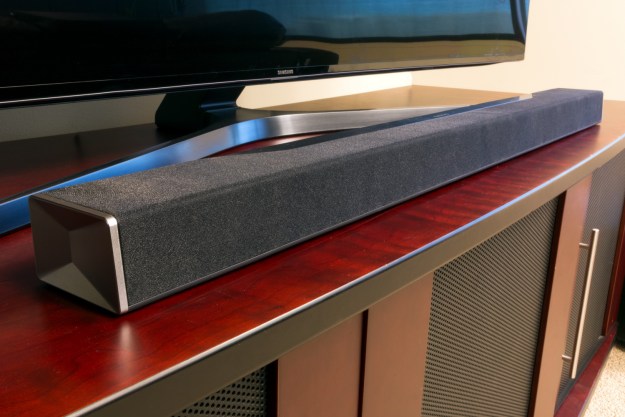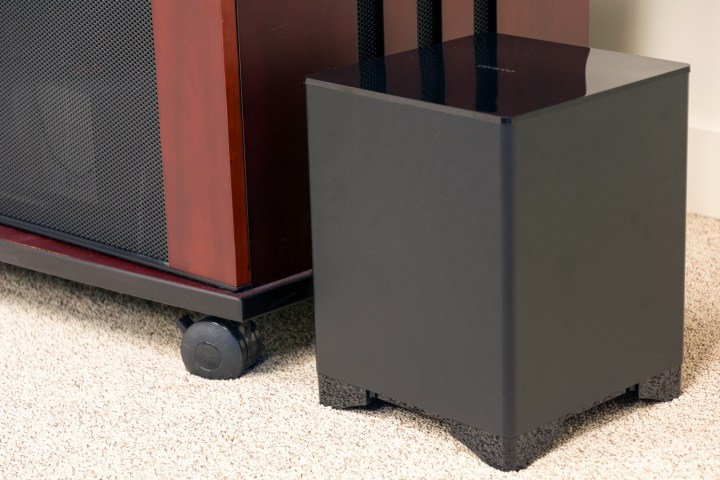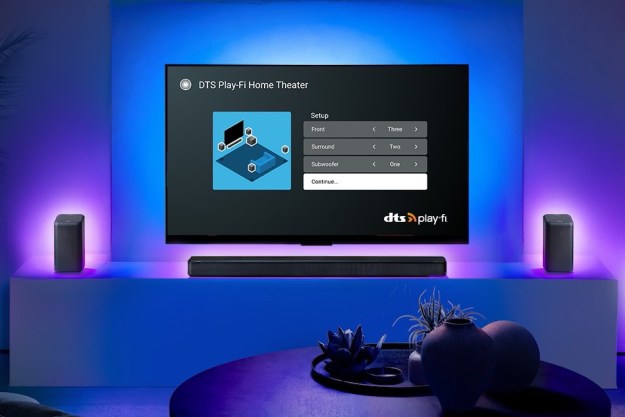
“The system’s Atmos experience never quite gets off the ground.”
- Rich and powerful bass response
- Well-balanced transition from bass to midrange
- Multiple future-proof features include 4K HDR passthrough
- Granular control over all settings
- Boxy midrange glosses over the details
- Flat soundstage, unconvincing Atmos/DTS:X height channels
- Overly complicated setup for a soundbar
Since Yamaha introduced the first Dolby Atmos soundbar in the summer of 2015, we’ve been patiently awaiting the age of the Atmos bar. Dolby Atmos — and its DTS counterpart DTS:X — represents a revolutionary cinema technology that not only frees sound mixers from the rigid restraints of traditional surround sound mixing, but also adds height speakers to engulf listeners in a hemispheric globe of sound. As you might imagine, it’s not easy squeezing all that tech into a soundbar — especially if you want believable results.
As such, it took a while before another rival took a crack at this tricky (and expensive) proposition, but Samsung’s HW-K950 arrived in the spring of 2016, adding wireless satellite speakers to the equation. By CES 2017, multiple other players announced Atmos intentions, including Onkyo with its SBT-A500, priced at $1,000.
Not all Atmos soundbars are created equal, however, and the word “Atmos” alone does not a thrilling surround-sound experience make. While the A500 is loaded with features, including multiple ways to play and an A/V receiver-style hub to drive the system, the unit’s scaled-down 3.1.2 configuration cuts back on surround-sound immersion in favor of a slimmer design (and a lower price tag). It’s exactly that kind of compromise that clips the A500’s wings, creating an Atmos experience that never quite gets off the ground.
Out of the box
You’d never guess from the packaging that Onkyo skimped on hardware for the A500. The unit arrives in a monstrous cardboard package that weighs around 40 pounds, and you’ll dig through a mountain of Styrofoam before uncovering the slim bar, the receiver hub, and matching subwoofer. The three-piece system looks as fancy as the suit of the same order, including the sleek hub that’s loaded with inputs at the back, and topped with crystal-white volume knob at the front for convenience and style points.
The bar is even slimmer than we remembered from its CES debut, stretching a mere 38 inches across, 3 inches deep, and 2 inches high — wonderfully diminutive for your TV stand, but curiously small for an Atmos bar. In turn, the rectangular sub reaches just 12 inches high on rubberized feet, topped with a slab of reflective plastic opposing a 6.5-inch down-firing driver.
Accessories include warranty info and a quickstart setup guide, a puck-shaped mic for speaker calibration, FM antenna cable, a mid-sized remote control and batteries, a proprietary soundbar connection cable, and a power cable for the sub. What we didn’t find, and expected in a soundbar at this price, was an HDMI cable, digital optical cable, or mounting screws. The full manual (which you’ll likely need) is also missing, offered only as a download.
Setup
As mentioned, Onkyo’s new toy is loaded to the brim with features, and its receiver hub allows for granular control over virtually every one of them, in the vein of a multi-piece surround setup. However, this means you don’t get the easy, plug-and-play setup configuration soundbars are renowned for. Once you’ve connected all the pieces, you must delve into the setup menu, a veritable labyrinth of settings that leaves some options curiously off by default.
The A500 boasts a fully stacked deck of wireless options.
The best setup for performance and convenience is connecting via HDMI to your ARC-enabled TV. This not only allows for the best sound, but also enables the TV remote to control basic soundbar functions, and requires only a single cable to send sound both to and from the TV. Normally, simply connecting an HDMI cable between TV and soundbar would do the trick, but Onkyo puts some kinks in the chain. Once the cable is connected, you must turn manually turn CEC on from within a buried menu, and change the input to the mysterious “—“ symbol.
This is a pain using just the receiver’s digital display, but selecting the ARC input from your TV puts the menu on-screen for easier access. An optional “Initial Setup” process uses the included mic to run a ridiculously long calibration process, though we’re not sure it helps much. Configuring the Wi-Fi allows for Chromecast, Airplay, and other Wi-Fi streaming options. There are multiple other options within the menu, so pro users will have plenty to futz with if desired.
(Note: Our unit arrived in dire need of a firmware update, which fixed multiple sound issues including an odd echo with certain connections. Users should scroll to Miscellaneous->Firmware Update and follow the instructions before continuing.)
You can then plug any of your components (including those with 4K and
If you don’t own an ARC-enabled TV, you can also simply connect to the Optical input, which is set to receive TV sound by default.
Features and design
As you can tell, the A500 is considerably more involved when it comes to connection than even many Atmos-enabled soundbars we’ve encountered. However, the system hopes to make up for it with a cornucopia of features.
Dual Wi-Fi antenna prongs on the receiver unit’s rear hint at a stacked deck of wireless options. Those include the aforementioned Chromecast and Airplay (great for Spotify and Apple Music respectively), multiroom wireless options in DTS Play-Fi and Onkyo’s nascent FireConnect, as well as good old Bluetooth. It’s the longest list of wireless options we’ve encountered in a soundbar, allowing for serious versatility. Built-in streaming options include Tidal, Pandora, Tune-in, Deezer, and Spotify Connect.
Four HDMI inputs allow for plenty of hardwired options, too, and each is HDCP 2.2 compatible with passthrough of 4K video at 60fps with HDR support, and even optional
As loaded as it is on the digital side, the A500 falls short when it comes to surround-sound hardware. Its 3.1.2 setup means there’s no actual surround sound happening here — virtual or otherwise. Only the height channels for object-based surround sound raise the sound beyond dead center. The left, right, and center channels use two 2.75-inch x 1.5-inch drivers apiece, while each of the dual height channels boast just a single 2.3-inch driver.
The heartiest component is the subwoofer, which boasts a surprisingly meaty 6.5-inch down-firing cone pushed by 50 watts. The outboard receiver/amp gives the system some muscle, but there’s just not enough firepower here to create a convincing Atmos/DTS:X experience.
Performance
The A500 is at its best when riding at full throttle, driven by the might of its tubby little subwoofer. The sub can be extremely powerful, especially when we tested the system at home where it appeared to couple with our living room’s hardwood floor for a spectacular burst of sonic muscle whenever things get toasty in the mix.
The subwoofer also blends quite well with the bar itself — once we checked its levels down a tad — allowing for a smooth transition from the bass into the midrange and treble (such as it is). There’s not much extension in the highest register, and that’s just the tip of the iceberg when it comes to the system’s overall performance insufficiencies.
To be sure, the A500 is far from devoid of detail, and that’s especially true at the tip of the midrange, where details like the attack of “S” consonances, footsteps on gravel, or a pistol’s hammer cock all ring out with equal parts clarity and subtlety.
The word “Atmos” alone does not a thrilling surround sound experience make.
It’s the middle of the frequency range that has the most trouble, however. Dialogue tends to get boxy quickly when tasked with rising above the fray of mayhem around it. The bombastic punch of the many action scenes in Deadpool, for instance, create a virtual slate in the center channel, where dialogue and other midrange effects can sound flattened.
Speaking of flat, while the Atmos/DTS:X height channels add some extension to the soundstage above your TV, it’s surprising how little they do to create the illusion of sound coming from overhead, even when fed scenes directly designed to showcase Atmos and DTS:X. Unlike the Atmos bars from Yamaha and Samsung — each of which depend on completely different methods to create surround effects — there is no illusion of envelopment, engulfment, or even basic dimension happening here.
A prime example was the Locked Up scene created in house at DTS. With other DTS:X-supported systems of either the traditional component or soundbar variety, the scene is absolutely captivating in its precision. A fly seems to buzz right next to your ears, while the slimy tongues of the toads are crafted with precision and dimensionality to the point of tricking your brain that they’re real. When played back with the A500, however, there was none of that. The scene is devoid of depth, and downright boring.
The system’s lack of sonic vibrance and depth played out for music streaming, as well. While the system doesn’t sound bad, it lacks the kind of presence you’d expect from a soundbar at this price point, or even below. Father John Misty’s Chateau Lobby #4 sounded almost distorted at times, and the stubby delivery seemed to pull the life from the song, rendering it fit for background listening at best.
Warranty
Onkyo’s limited warranty covers parts and service for defective soundbars for a period of two year. However, the company does not warranty products purchased from unauthorized websites, including Amazon and a host of others. You can find out more here.
Our Take
While Onkyo’s SBT-A500 has its moments, including powerful sound performance that can rattle your walls, the system is simply incapable of crafting the kind of detail, presence, or rich dimensionality we’d expect from a soundbar at this price point, Atmos enabled or otherwise.
How long will it last
As far as durability, the SBT-A500 appears to be well built and it’s backed by a titan in the audio industry. The system’s inclusion of features like
What are the alternatives
While more expensive, Samsung’s HW-K950 Atmos bar offers a true surround-sound experience, better detail and overall fidelity, and a more intuitive interface for its $1,500 price point. If $1,000 is your limit, we suggest considering letting go of those Atmos dreams and simply landing yourself one of many high-quality solutions in this price range, including Definitive Technology’s Mighty Mouse W Studio Micro, Yamaha’s YSP-2500, or even something from Paradigm’s brilliant Soundtrack line — though the latter options are quite a bit bigger.
Otherwise, you could also choose to save some green on a true surround-sound experience sans Atmos or DTS:X with one of Vizio’s highly affordable surround soundbars.
Should you buy it
No. The word Atmos may be hot right now, but not all Atmos/DTS:X experiences are the same — especially in the burgeoning Atmos soundbar market. While Onkyo’s fully-loaded SBT-A500 isn’t without its moments on the performance side, this $1,000 system doesn’t do enough to raise the arm hairs when it comes to creating believable Atmos envelopment, making it one surround sound experience (or lack thereof) worth avoiding.
Editors' Recommendations
- Samsung launches its flagship Dolby Atmos soundbar with discounted prices
- TCL goes all-in on Dolby Atmos with its first 7.1.4-channel soundbar
- Samsung’s flagship HW-Q990D Dolby Atmos soundbar gets Roon support
- Bose’s new flagship Dolby Atmos soundbar brings AI smarts to the dialogue problem
- Sennheiser’s Ambeo Soundbar Mini is a pricey, bedroom-sized Dolby Atmos speaker







